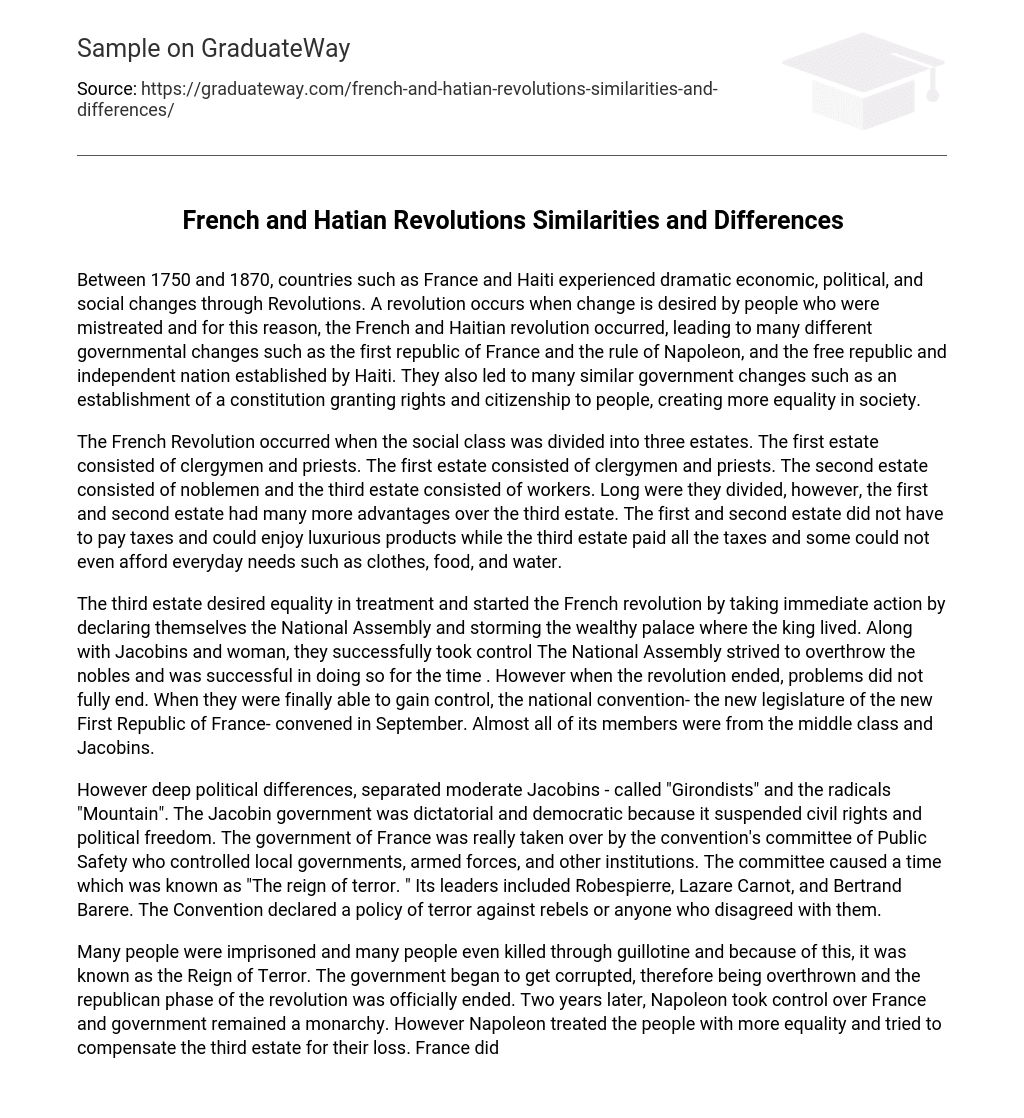From 1750 to 1870, France and Haiti experienced notable changes in their economy, politics, and society due to revolutionary movements. Revolutions occur when oppressed populations seek change. Consequently, the French and Haitian revolutions occurred, causing different governmental transformations like the formation of France’s initial republic and Napoleon’s ascent, along with Haiti’s emergence as a liberated republic and an independent country. Additionally, both revolutions exhibited resemblances in terms of governmental modifications; for instance, enacting constitutions that bestowed rights and citizenship upon individuals resulted in enhanced societal equality.
The French Revolution occurred during the societal division into three estates: the first estate, which included clergymen and priests; the second estate, consisting of noblemen; and the third estate, composed of workers. Despite this division, the first and second estates enjoyed significant advantages over the third estate. They were exempt from taxes and could indulge in luxurious goods, while all tax obligations fell upon the third estate. Certain individuals within this estate even struggled to afford essential needs such as clothing, food, and water.
The third estate initiated the French revolution by demanding equality and promptly declaring themselves the National Assembly. They then stormed the opulent palace where the king resided, joined by Jacobins and women, ultimately gaining control. The National Assembly sought to overthrow the nobles and achieved temporary success. Nonetheless, upon the revolution’s conclusion, issues persisted. In September, the national convention convened, serving as the legislative body of the new First Republic of France. Consisting predominantly of middle-class individuals and Jacobins, it marked a period when they finally seized power.
Despite their deep political differences, the moderate Jacobins, known as the “Girondists,” and the radical faction, known as the “Mountain,” were separated. The Jacobin government, while dictatorial, also displayed democratic elements by suspending civil rights and political freedoms. The convention’s committee of Public Safety took control of France’s government, local authorities, armed forces, and other institutions. This committee led to a period known as “The Reign of Terror,” with leaders such as Robespierre, Lazare Carnot, and Bertrand Barere. The Convention implemented a policy of terror against rebels and dissenting voices.
During the Reign of Terror, numerous individuals were imprisoned and executed by guillotine, earning it its infamous reputation. The corruption within the government ultimately led to its overthrow, marking the official end of the republican phase of the revolution. Subsequently, Napoleon assumed power in France, establishing a monarchy. Nevertheless, under Napoleon’s rule, there was a greater emphasis on equality and attempts were made to compensate the third estate for their sufferings. In contrast to the French revolution, the Haitian revolution was victorious in its slave uprising for the establishment of a free republic.
In 1791, the Haitian revolution commenced as slaves in Haiti rallied together to revolt. While the French revolution unfolded, the Haitian slaves found great inspiration in the events happening across the ocean. Consequently, they seized this momentous occasion to initiate their own revolution. As a result of their courageous efforts, the Haitians successfully fought against the French. Under the guidance of Toussaint, the slaves proclaimed their independence, ultimately establishing the free republic of Haiti. This significant achievement led to Haiti becoming the second independent nation in the Western Hemisphere, joining forces with the United States.
Many individuals sacrificed their lives in order to achieve independence and emancipation. This period was marked by countless casualties and a decline in the economy and political system. Unlike its French counterpart controlled by Napoleon, the Haitian government successfully secured independence and achieved their desired outcome. However, a key difference between the two revolutions was that the French Revolution eliminated unequal social classes among the first, second, and third estates.
After the Revolution, the tax system was abolished, bringing financial and social relief to the common people, also known as the third estate. It also granted them an opportunity to have more influence over their country’s economic decisions. The authority of the clergy was limited or entirely eliminated, resulting in a new social order marked by equality among all individuals in society. They all possessed equal rights and freedoms based on natural rights. Moreover, legislatures were implemented to enable the election of representatives who would advocate for the people’s interests, and universal male suffrage was instituted.
Both the French Revolution and the Haitian Revolution led to the establishment of a constitution that granted rights and citizenship to all individuals in Haiti. In both cases, slaves were liberated and gained freedom. The 3rd estate in France also had the opportunity to achieve equality. Furthermore, neighboring countries in the Caribbean relied on Haiti’s production of crops and sugar cane, so the absence of slave labor would have affected their ability to export and generate income. As a result, there were similarities and differences in governmental changes that occurred in Haiti and France due to these revolutions.
Between 1750 and 1870, both France and Haiti underwent notable government transformations as a result of revolutions that led to social, economic, and political changes. In France, the French Revolution saw the establishment of its initial republic, which was ultimately replaced by Napoleon’s governance. Conversely, the Haitian Revolution enabled slaves to revolt effectively and create an autonomous nation. Consequently, these revolutions spurred significant governmental shifts in both France and Haiti.





